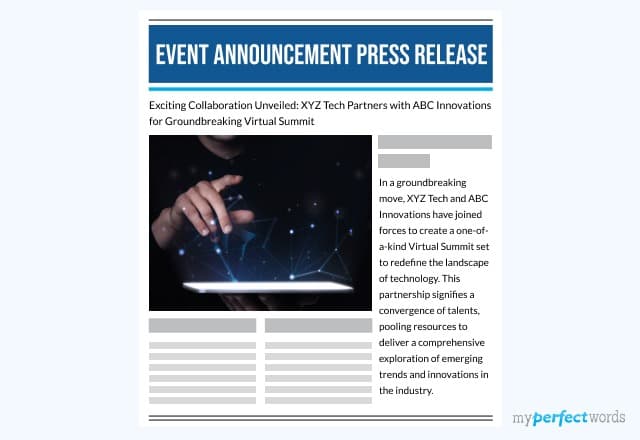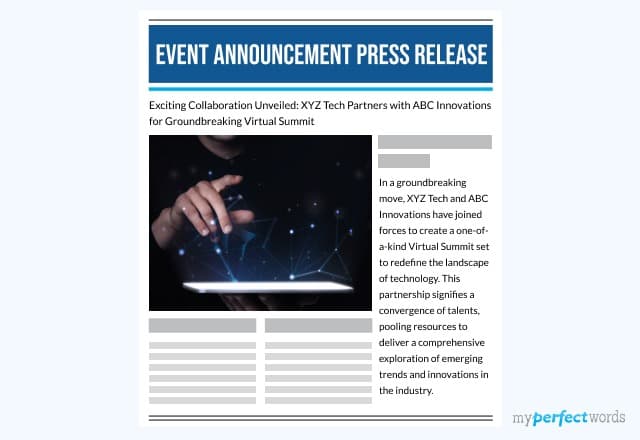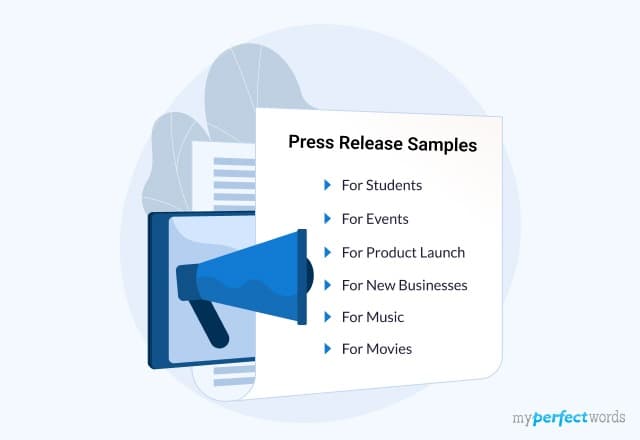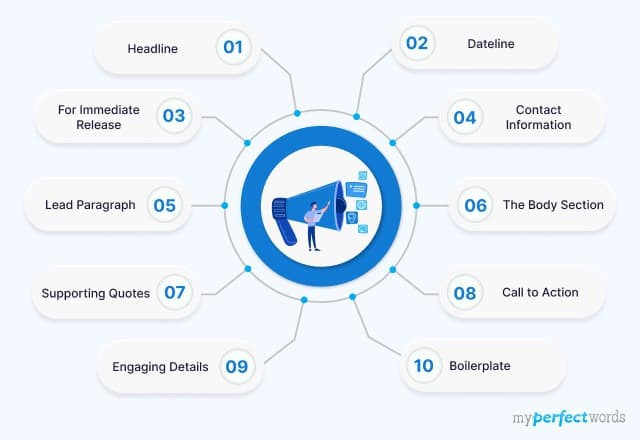

Writing a press release sounds easy, but getting it right can be tricky. Many businesses know they need a press release to share important news, but struggle to create one that truly grabs attention. This often leads to missed chances for media coverage and customer interest.
If a press release isn't well-structured, it can get lost in the flood of information, with journalists ignoring it and potential customers never seeing the news.
The good news is, writing an effective press release is simple when you know the right steps. Whether you’re announcing a new product, business launch, or award, following a clear guide can make all the difference.
In this blog, we’ll walk you through everything you need to know about press releases, from their purpose to the key steps for writing one that stands out.
Let’s get started!
On This Page![]()
- 1. What is a Press Release?
- 2. Types of Press Releases
- 3. How to Write a Press Release in 7 Easy Steps
- 4. The Right Format for a Press Release
- 5. Free Press Release Templates
- 6. Examples of Effective Press Releases
- 7. How to Distribute a Press Release
- 8. 4 Tips to Make Your Press Release Stand Out
What is a Press Release?
A press release is designed to communicate essential information about an event, product launch, achievement, or other newsworthy developments.
It serves as a formal announcement to the media and the public, providing journalists and other stakeholders with the key details they need to create news stories.
A well-crafted press release in public relations can enhance brand visibility, build credibility, and spark conversations in traditional and digital media channels.
Types of Press Releases
Press releases come in various forms, each tailored to address specific communication needs. Understanding the different types of press releases allows communicators to choose the most suitable format for their announcements.
Here are the most common types:
New Business or Location Opening
This press release announces the launch of a new business or branch. Include details like the location, opening date, and any special events or promotions. It’s an invitation for everyone to come and celebrate the new venture.
New Leadership Hire
Use this press release to introduce a new key leader. Share their background, role, and what they bring to the company. It’s a way to get everyone excited about the fresh leadership.
New Product or Service Launch
Announce a new product or service with details about its features, benefits, release date, and pricing. This press release aims to generate buzz and inform potential customers about the exciting new offering.
Upcoming Event
This press release provides details about an upcoming event—date, time, location, agenda, and registration info. It’s a way to build interest and ensure people know how to attend.
New Partnership
Announce a new partnership by highlighting the goals, benefits, and roles of each party involved. This press release shows how the collaboration will create value for both organizations.
Industry Award Win
Celebrate an award win with a press release detailing the award’s significance, the recipient, and its impact. Include quotes to highlight the achievement and spread the excitement.
Acquisition or Merger
Use this press release to explain an acquisition or merger. Provide details on the companies involved, the deal’s benefits, and any changes. It reassures stakeholders about the positive effects of the deal.
Crisis Management Statements
Address a crisis with a press release explaining what happened, the steps being taken to resolve it, and how you’re preventing future issues. It’s about being transparent and reassuring stakeholders that the situation is under control.
How to Write a Press Release in 7 Easy Steps
Here are seven simple steps to help you craft a press release that grabs attention and delivers your message effectively:
Step 1: Provide Essential Information for Journalists
Begin your press release by offering all the necessary details journalists need to know right away. This helps streamline communication and answers initial questions. Be sure to include:
- Company logo: Place it in the top right corner.
- Company name: Position it in the top left corner.
- Media contact: List the name, job title, phone number, and email address of the media contact below the company name.
- Release date: Specify when the press release is issued.
- Release instructions: Indicate when the press release can be shared. Options include:
- For immediate release: Share right away.
- For release [date/time]: Can be shared later.
- Embargoed until [date/time]: Cannot be released until the specified date/time.
Pro Tip: Double-check contact information for accuracy. Ensure the media contact details are up-to-date to avoid missed opportunities for media coverage.
Step 2: Craft an Attention-Grabbing Headline
The headline is crucial for catching the eye of both journalists and readers. It should clearly state the core news, be concise, and appeal to your audience.
Depending on the content, a straightforward headline may suffice. Place the headline just below the contact information and release instructions. You can also add a subtitle to emphasize key points not included in the headline.
Pro Tip: Use action verbs and strong language in your headline to make it more compelling. Keep it under 80 characters to ensure it's easily readable in various formats.
Step 3: Include a Relevant Dateline
The dateline shows when and where the press release is issued. For immediate releases, use the current date; for embargoed or future releases, adjust the date accordingly.
The dateline is positioned at the start of the lead paragraph, formatted as [Date, City, State]—Lead paragraph.
Pro Tip: Ensure the dateline is formatted correctly to avoid confusion. It should match the release timing and location to align with your distribution strategy.
Step 4: Write a Compelling Lead Paragraph
The lead paragraph, also known as the "lede," should summarize the most important aspects of your news.
It should answer the basic questions: Who, What, Where, When, and optionally, Why. A strong lead paragraph increases the likelihood that journalists will cover your story.
Pro Tip: Focus on the most newsworthy elements in your lead paragraph. Make it engaging to grab attention and encourage readers to continue.
Step 5: Expand in the Body Copy
In the body of the press release, provide more detail and context to support your headline and lead paragraph. This section can include quotes, statistics, background information, and other relevant details.
Organize the content by importance, with the most critical information first. Keep the press release concise—around 400 words is ideal—and conclude with a clear call to action.
Pro Tip: Use bullet points or subheadings to make key details stand out. This makes it easier for journalists to quickly scan and extract important information.
Step 6: Add Boilerplate Information and End Notation
End the press release with a boilerplate, a brief "About Us" section that gives readers essential information about your company. This should include your company name, stock symbol (if applicable), a short description, unique value propositions, and key achievements.
If the press release involves multiple companies, provide boilerplates for each. Finally, include an end notation (typically “###”) to indicate the end of the press release.
Pro Tip: Ensure the boilerplate is current and accurately represents your company’s mission and values. The end notation should be clearly visible to indicate the press release's conclusion.
Step 7: Proofreading and Publishing
Before publishing, thoroughly proofread the press release to catch any errors or inconsistencies. Check for grammar, spelling, and factual accuracy. Consider having a colleague review it for a fresh perspective.
Pro Tip: Use proofreading tools or hire a professional editor to ensure your press release is polished. Review it one last time before distribution to ensure everything is perfect.
Publishing Tip: Choose the right channels for distribution, such as news wires, media lists, or direct outreach to journalists. Monitor the release’s performance and follow up with key contacts if needed.
The Right Format for a Press Release
A well-structured press release ensures that your news is effectively communicated to journalists and the public.
- Headline: A compelling, attention-grabbing statement that summarizes the key message of the announcement.
- Dateline: Includes the release date and the location of the announcement. This establishes both timeliness and relevance.
- Introduction: A concise summary answering the essential questions: Who is making the announcement? What is happening? Where and when will it occur? Why is it significant? How will it take place? This section sets the tone for the rest of the release.
- Body: Provides in-depth information expanding on the introduction. It includes supporting details, background information, quotes from key stakeholders, and relevant context.
- Boilerplate: A brief, standardized description of the company or organization issuing the press release. This typically includes its mission, history, and key services or products for context.
- Contact Information: Lists essential details for media inquiries, such as the contact person's name, phone number, email address, and, where applicable, social media profiles.
Read this blog for more information about press release format.
Here is a perfect format that you can follow for your press release:
- Length: Keep the press release concise, ideally between 300 to 500 words.
- Headline: Keep it concise, ideally under 100 characters, and make it attention-grabbing.
- Font and Style: Use a standard, easy-to-read font such as Arial or Times New Roman. Use a font size between 10 and 12 points.
- Spacing: Double-space the entire press release for readability. Leave space between paragraphs to avoid a cluttered appearance.
- Margins: Set one-inch margins on all sides of the document.
- Headings and Subheadings: Use bold or uppercase for the headline. Use subheadings to break up the text and guide readers through the information.
Here is a press release format example according to the guidelines:
Free Press Release Templates
Press releases are powerful tools for sharing important news with the world. Below are template structures for three specific types of press releases:
Examples of Effective Press Releases
Press releases can be valuable tools for students to showcase their achievements, share noteworthy events, or promote initiatives within the academic community.
Here are some press release examples to understand how to structure press releases effectively.
Operational and Financial Update from Reconnaissance Energy

News Source: PR Newswire
Summary: The press release begins with a brief overview of the company's latest milestones, including key drilling achievements and recent financial moves. This gives readers a snapshot of the most important updates.
Details: In the body, specific details about the depth of the well, investment figures, and future project plans are shared. This section uses factual information to inform stakeholders about ongoing operations.
Closing Remarks: The release concludes with a focus on the company's commitment to sustainability, acknowledging both the potential risks and future goals. This demonstrates transparency and forward-thinking.
Product Launch Announcement from Primax Electronics

News Source: PR Newswire
Summary: The press release opens by announcing Primax Electronics' new HOC miniature camera module. It provides a quick highlight of the product’s innovation and market importance, engaging readers from the start.
Market Relevance: The body discusses market trends and positions the camera module within a growing industry. Simple data and projections are used to demonstrate its relevance, helping readers understand the product's value.
Technical Details: The release concludes by detailing the technical features and applications of the camera module. Using straightforward language, it explains the technology and emphasizes the company’s commitment to quality and innovation.
How to Distribute a Press Release
Once your press release is ready, the next crucial step is ensuring it reaches the right audience. There are several effective ways to distribute one, each with its own set of advantages. Here are the most popular press release distribution methods:
Releasing via Newswires
Newswire services are an efficient way to distribute your press release to a large audience. They send your release to a network of media outlets, including newspapers, online platforms, and newsrooms.
These services often offer different distribution packages based on region, industry, or audience size. This ensures that your press release reaches the right people. Plus, many newswires provide analytics, so you can track how well your release performs by viewing metrics like audience reach and media pickups.
Distributing Directly to Journalists
Reaching out to journalists directly is a more targeted approach. Start by identifying journalists who cover topics related to your press release. Then, send personalized emails that explain why your story matters to their readers.
Use a short, attention-grabbing subject line and include a brief press release summary. You can also attach additional resources like images or quotes to strengthen your pitch. Tailoring your message increases the chances that your press release will be published.
Working with PR Agencies or Freelancers
PR agencies and freelancers offer valuable expertise and connections that can help boost your press release distribution. They have strong relationships with the media and know how to craft a release that appeals to both journalists and the public.
These professionals can handle the entire distribution process, whether through newswires or direct pitching, and may even arrange media interviews. PR agencies also have access to exclusive tools and databases, further increasing the reach and impact of your press release.
4 Tips to Make Your Press Release Stand Out
Publishing a press release is only the start. To make sure it reaches the widest audience possible, follow these four tips for effective distribution:
Target the Right Journalists
Instead of sending your press release to a long list of journalists, focus on those who cover your industry. Personalize your message to explain why your news is relevant to their work. There are tools that offer press distribution service that can help you find and connect with the right journalists efficiently.
Send Your Release Under Embargo
Send your press release to journalists a day before it officially goes live, and specify that it's under embargo. This means they can prepare their stories but won’t be able to publish them until the designated time. This approach can help generate interest and ensure your news is covered thoughtfully.
Avoid Common Publishing Times
When using distribution services like PR Newswire or Business Wire, avoid publishing your press release exactly on the hour. Many companies schedule their releases at these times, making it easy for yours to get lost in the crowd. Choose a unique time, such as 1:12 p.m. or 3:18 p.m., to stand out.
Promote Your Media Coverage
If your press release gets picked up by the media, share the resulting articles and stories to keep the buzz alive. Spread the news through your own digital channels, such as social media and email newsletters, to boost visibility and drive more attention to your announcement.
In conclusion, by focusing on clear communication and using the right format, you can make sure your press release stands out. Start with a compelling headline, provide all the key details in the lead, and back it up with relevant information in the body. With these straightforward steps, you’ll be able to craft press releases that catch attention and get results.
Still finding it hard to write a perfect press release? Let us handle it for you!
Our expert writers are here to turn your thoughts into compelling narratives, ensuring clarity and precision in every word.
So, place your 'write essay for me' request and let your ideas shine with the help of our professional touch!
Frequently Asked Questions
What is A Press Release In Marketing?
A press release in marketing is a strategic communication tool used to share newsworthy information about a product, or event with the media and the public. It serves as an official announcement, crafted in a journalistic style, with the goal of generating media coverage and increasing visibility.

Write Essay Within 60 Seconds!
Use our AI tool to generate high quality essayWRITTEN BY
Alexander P.
Harvard Law graduate. I write law essays with the precision and rigor expected at top law schools.
Keep reading
The Proper Press Release Format in 2025
-10594.jpg&w=828&q=75&dpl=dpl_4f4VU87XynDmuWZvXA7fJDuQ5GRt)
10+ Press Release Examples to Get Media Coverage in 2025

Key Elements of Press Release You Need to Know

Understanding Various Types of Press Releases with Real-Life Examples

Press Release Distribution: Best Services and How to Do It Right
